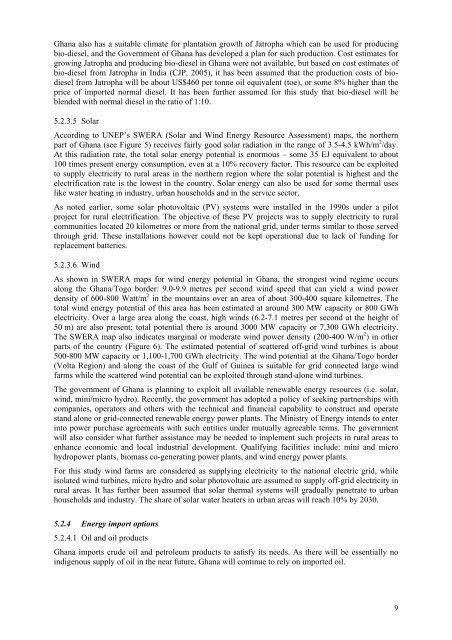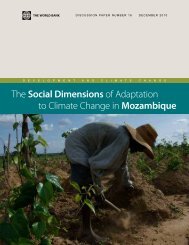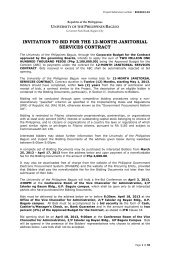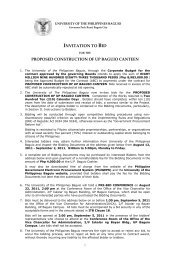Ghana - UNEP
Ghana - UNEP
Ghana - UNEP
- No tags were found...
Create successful ePaper yourself
Turn your PDF publications into a flip-book with our unique Google optimized e-Paper software.
<strong>Ghana</strong> also has a suitable climate for plantation growth of Jatropha which can be used for producingbio-diesel, and the Government of <strong>Ghana</strong> has developed a plan for such production. Cost estimates forgrowing Jatropha and producing bio-diesel in <strong>Ghana</strong> were not available, but based on cost estimates ofbio-diesel from Jatropha in India (CJP, 2005), it has been assumed that the production costs of biodieselfrom Jatropha will be about US$460 per tonne oil equivalent (toe), or some 8% higher than theprice of imported normal diesel. It has been further assumed for this study that bio-diesel will beblended with normal diesel in the ratio of 1:10.5.2.3.5 SolarAccording to <strong>UNEP</strong>’s SWERA (Solar and Wind Energy Resource Assessment) maps, the northernpart of <strong>Ghana</strong> (see Figure 5) receives fairly good solar radiation in the range of 3.5-4.5 kWh/m 2 /day.At this radiation rate, the total solar energy potential is enormous – some 35 EJ equivalent to about100 times present energy consumption, even at a 10% recovery factor. This resource can be exploitedto supply electricity to rural areas in the northern region where the solar potential is highest and theelectrification rate is the lowest in the country. Solar energy can also be used for some thermal useslike water heating in industry, urban households and in the service sector.As noted earlier, some solar photovoltaic (PV) systems were installed in the 1990s under a pilotproject for rural electrification. The objective of these PV projects was to supply electricity to ruralcommunities located 20 kilometres or more from the national grid, under terms similar to those servedthrough grid. These installations however could not be kept operational due to lack of funding forreplacement batteries.5.2.3.6 WindAs shown in SWERA maps for wind energy potential in <strong>Ghana</strong>, the strongest wind regime occursalong the <strong>Ghana</strong>/Togo border: 9.0-9.9 metres per second wind speed that can yield a wind powerdensity of 600-800 Watt/m 2 in the mountains over an area of about 300-400 square kilometres. Thetotal wind energy potential of this area has been estimated at around 300 MW capacity or 800 GWhelectricity. Over a large area along the coast, high winds (6.2-7.1 metres per second at the height of50 m) are also present; total potential there is around 3000 MW capacity or 7,300 GWh electricity.The SWERA map also indicates marginal or moderate wind power density (200-400 W/m 2 ) in otherparts of the country (Figure 6). The estimated potential of scattered off-grid wind turbines is about500-800 MW capacity or 1,100-1,700 GWh electricity. The wind potential at the <strong>Ghana</strong>/Togo border(Volta Region) and along the coast of the Gulf of Guinea is suitable for grid connected large windfarms while the scattered wind potential can be exploited through stand-alone wind turbines.The government of <strong>Ghana</strong> is planning to exploit all available renewable energy resources (i.e. solar,wind, mini/micro hydro). Recently, the government has adopted a policy of seeking partnerships withcompanies, operators and others with the technical and financial capability to construct and operatestand alone or grid-connected renewable energy power plants. The Ministry of Energy intends to enterinto power purchase agreements with such entities under mutually agreeable terms. The governmentwill also consider what further assistance may be needed to implement such projects in rural areas toenhance economic and local industrial development. Qualifying facilities include: mini and microhydropower plants, biomass co-generating power plants, and wind energy power plants.For this study wind farms are considered as supplying electricity to the national electric grid, whileisolated wind turbines, micro hydro and solar photovoltaic are assumed to supply off-grid electricity inrural areas. It has further been assumed that solar thermal systems will gradually penetrate to urbanhouseholds and industry. The share of solar water heaters in urban areas will reach 10% by 2030.5.2.4 Energy import options5.2.4.1 Oil and oil products<strong>Ghana</strong> imports crude oil and petroleum products to satisfy its needs. As there will be essentially noindigenous supply of oil in the near future, <strong>Ghana</strong> will continue to rely on imported oil.9
















